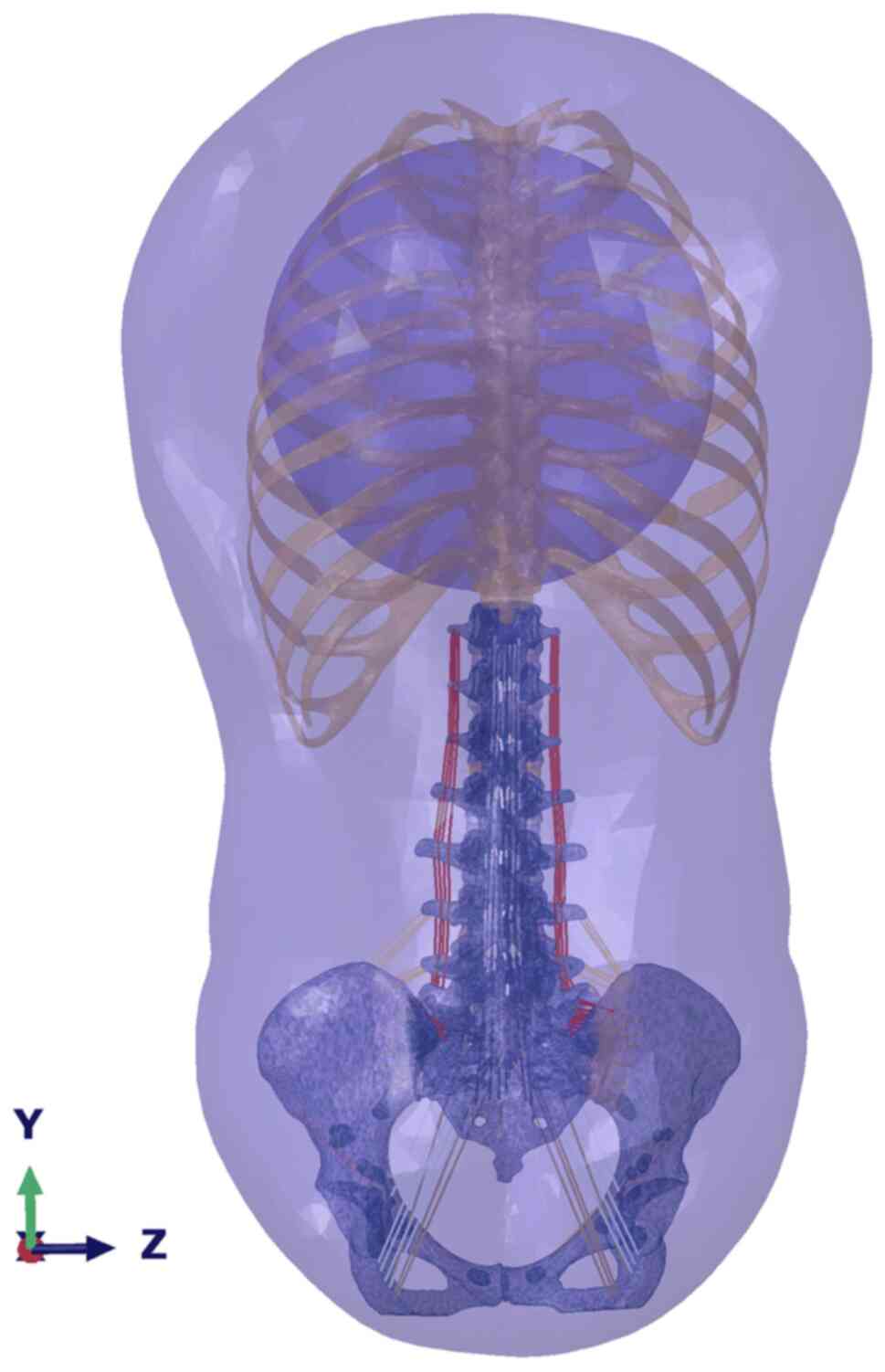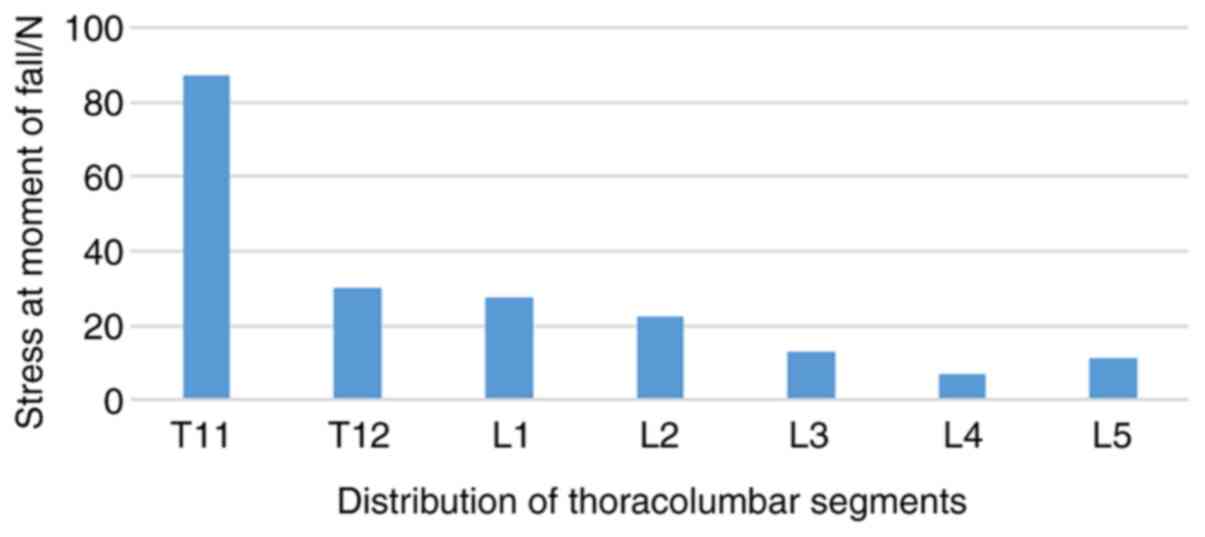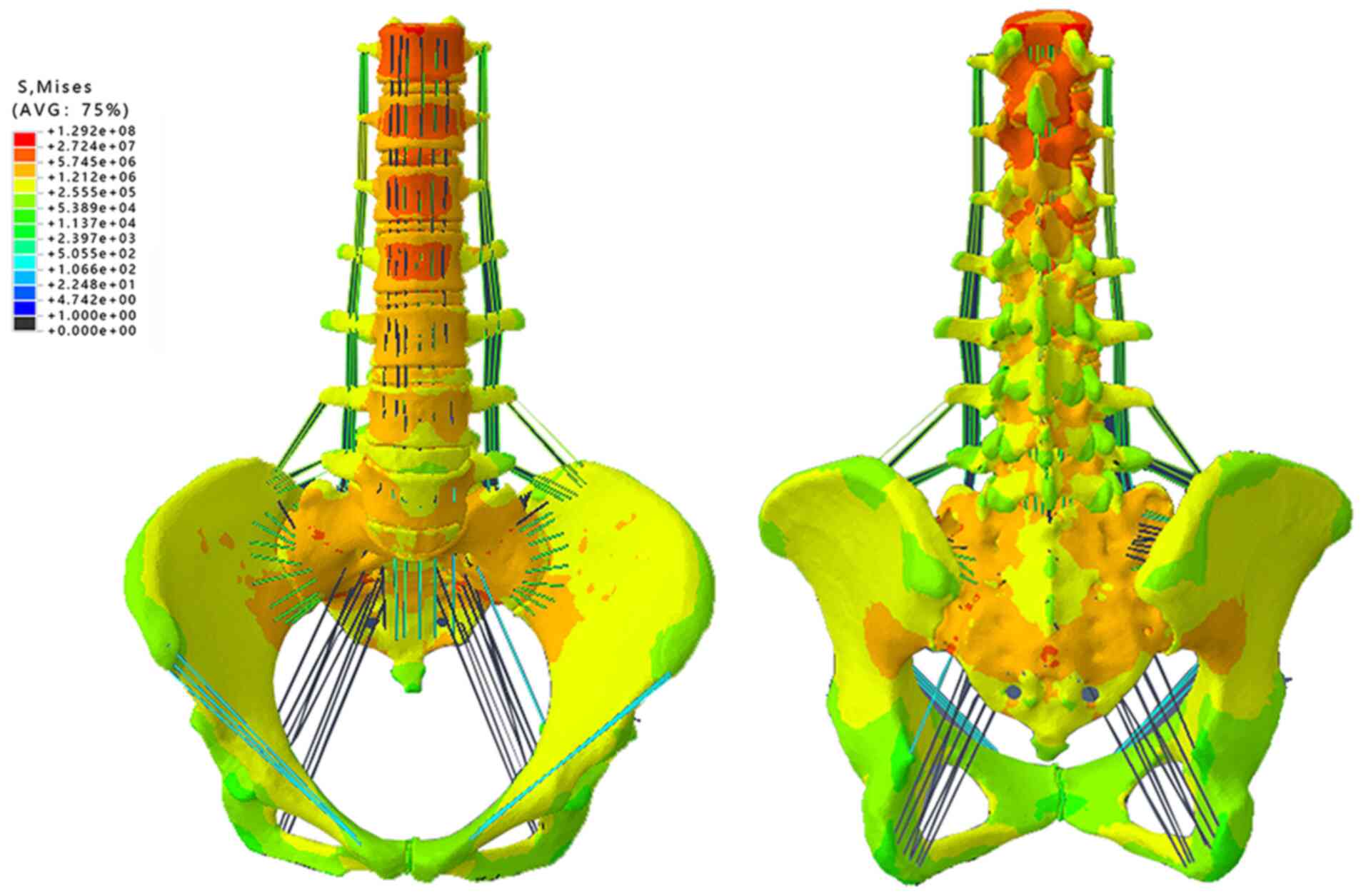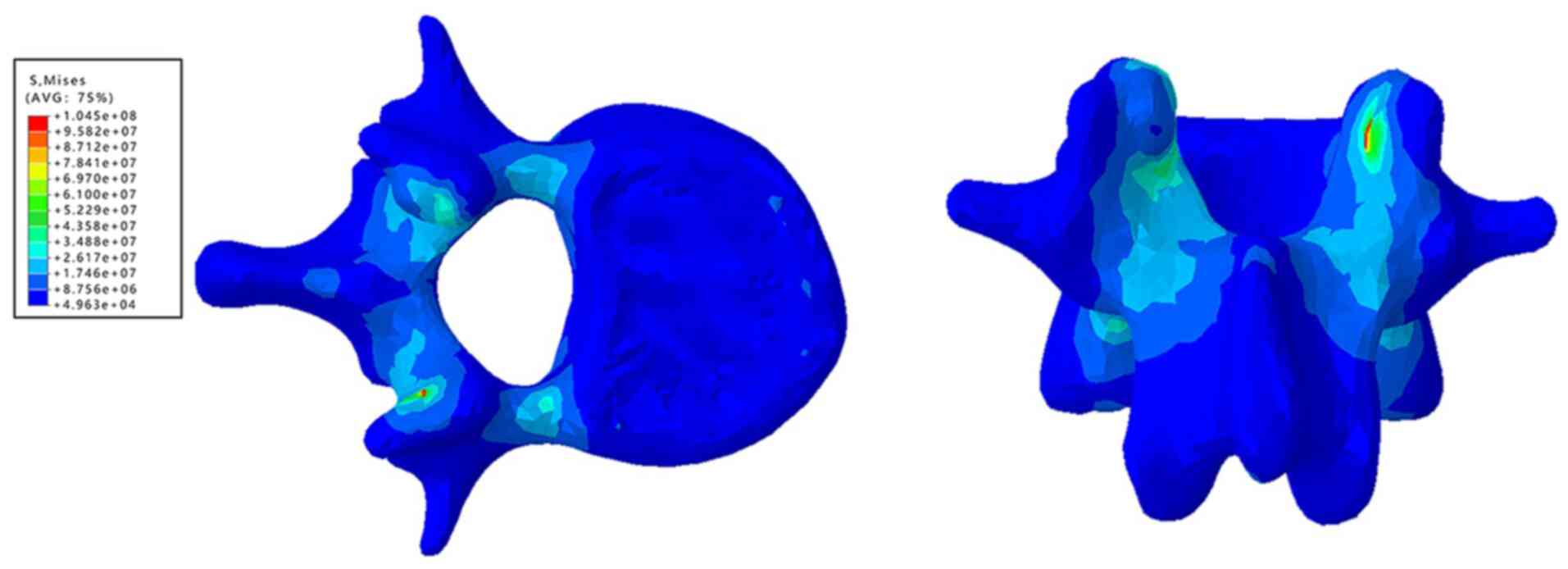|
1
|
Lee H, Jung M, Lee KK and Lee SH: A 3D
human-machine integrated design and analysis framework for squat
exercises with a smith machine. Sensors (Basel).
17(17)2017.PubMed/NCBI View Article : Google Scholar
|
|
2
|
Li B, Sun C, Zhao C, Yao X, Zhang Y, Duan
H, Hao J, Guo X, Fan B, Ning G, et al: Epidemiological profile of
thoracolumbar fracture (TLF) over a period of 10 years in Tianjin,
China. J Spinal Cord Med. 42:178–183. 2019.PubMed/NCBI View Article : Google Scholar
|
|
3
|
Hughes M, Ashour R and Rao J: Treatment of
thoracolumbar burst fractures using orthosis versus no orthosis.
BMJ Evid Based Med. 24:70–71. 2019.PubMed/NCBI View Article : Google Scholar
|
|
4
|
Chang V and Holly LT: Bracing for
thoracolumbar fractures. Neurosurg Focus. 37(E3)2014.PubMed/NCBI View Article : Google Scholar
|
|
5
|
Diaz JJ Jr, Cullinane DC, Altman DT,
Bokhari F, Cheng JS, Como J, Gunter O, Holevar M, Jerome R, Kurek
SJ Jr, et al: EAST Practice Management Guideline Committee:
Practice management guidelines for the screening of thoracolumbar
spine fracture. J Trauma. 63:709–718. 2007.PubMed/NCBI View Article : Google Scholar
|
|
6
|
Sran MM and Robinovitch SN: Preventing
fall-related vertebral fractures: Effect of floor stiffness on peak
impact forces during backward falls. Spine. 33:1856–1862.
2008.PubMed/NCBI View Article : Google Scholar
|
|
7
|
Van Toen C, Sran MM, Robinovitch SN and
Cripton PA: Transmission of force in the lumbosacral spine during
backward falls. Spine. 37:E519–E527. 2012.PubMed/NCBI View Article : Google Scholar
|
|
8
|
Gilbertson LG, Goel VK, Kong WZ and
Clausen JD: Finite element methods in spine biomechanics research.
Crit Rev Biomed Eng. 23:411–473. 1995.PubMed/NCBI View Article : Google Scholar
|
|
9
|
Al Qahtani WMS and El-Anwar MI: Advanced
Computational Methods in Bio-Mechanics. Open Access Maced J Med
Sci. 6:742–746. 2018.PubMed/NCBI View Article : Google Scholar
|
|
10
|
Tyndyka MA, Barron V, McHugh PE and
O'Mahoney D: Generation of a finite element model of the
thoracolumbar spine. Acta Bioeng Biomech. 9:35–46. 2007.PubMed/NCBI
|
|
11
|
Jones AC and Wilcox RK: Finite element
analysis of the spine: Towards a framework of verification,
validation and sensitivity analysis. Med Eng Phys. 30:1287–1304.
2008.PubMed/NCBI View Article : Google Scholar
|
|
12
|
Karimi MT, Rabczuk T and Pourabbas B:
Evaluation of the efficiency of various force configurations on
scoliotic, lordotic and kyphotic curves in the subjects with
scoliosis. Spine Deform. 8:361–367. 2020.PubMed/NCBI View Article : Google Scholar
|
|
13
|
Roy DK, O'Neill TW, Finn JD, Lunt M,
Silman AJ, Felsenberg D, Armbrecht G, Banzer D, Benevolenskaya LI,
Bhalla A, et al: Determinants of incident vertebral fracture in men
and women: results from the European Prospective Osteoporosis Study
(EPOS). Osteoporosis Int. 14:19–26. 2003.PubMed/NCBI View Article : Google Scholar
|
|
14
|
Cao KD, Grimm MJ and Yang KH: Load sharing
within a human lumbar vertebral body using the finite element
method. Spine. 26:E253–E260. 2001.PubMed/NCBI View Article : Google Scholar
|
|
15
|
Imai K, Ohnishi I, Bessho M and Nakamura
K: Nonlinear finite element model predicts vertebral bone strength
and fracture site. Spine. 31:1789–1794. 2006.PubMed/NCBI View Article : Google Scholar
|
|
16
|
Ivancic PC: Hybrid cadaveric/surrogate
model of thoracolumbar spine injury due to simulated fall from
height. Accid Anal Prev. 59:185–191. 2013.PubMed/NCBI View Article : Google Scholar
|
|
17
|
Panjabi MM, Hoffman H, Kato Y and
Cholewicki J: Superiority of incremental trauma approach in
experimental burst fracture studies. Clin Biomech (Bristol, Avon).
15:73–78. 2000.PubMed/NCBI View Article : Google Scholar
|
|
18
|
Lee SC, Ding J, Prosser LA, Wexler AS and
Binder-Macleod SA: A predictive mathematical model of muscle forces
for children with cerebral palsy. Dev Med Child Neurol. 51:949–958.
2009.PubMed/NCBI View Article : Google Scholar
|
|
19
|
Terrier A, Latypova A, Guillemin M, Parvex
V and Guyen O: Dual mobility cups provide biomechanical advantages
in situations at risk for dislocation: A finite element analysis.
Int Orthop. 41:551–556. 2017.PubMed/NCBI View Article : Google Scholar
|
|
20
|
Khalili M, Borisoff JF and Van der Loos
HF: Developing safe fall strategies for lower limb exoskeletons.
IEEE Int Conf Rehabil Robot. 2017:314–319. 2017.PubMed/NCBI View Article : Google Scholar
|
|
21
|
Majumder S, Roychowdhury A and Pal S:
Simulation of hip fracture in sideways fall using a 3D finite
element model of pelvis-femur-soft tissue complex with simplified
representation of whole body. Med Eng Phys. 29:1167–1178.
2007.PubMed/NCBI View Article : Google Scholar
|
|
22
|
Majumder S, Roychowdhury A and Pal S:
Effects of trochanteric soft tissue thickness and hip impact
velocity on hip fracture in sideways fall through 3D finite element
simulations. J Biomech. 41:2834–2842. 2008.PubMed/NCBI View Article : Google Scholar
|
|
23
|
Li J, Chen D, Tang X and Li H: On the
protective capacity of a safety vest for the thoracic injury caused
by falling down. Biomed Eng Online. 18(40)2019.PubMed/NCBI View Article : Google Scholar
|
|
24
|
Gertzbein SD, Khoury D, Bullington A, St.
John TA and Larson AI: Thoracic and lumbar fractures associated
with skiing and snowboarding injuries according to the AO
Comprehensive Classification. Am J Sports Med. 40:1750–1754.
2012.PubMed/NCBI View Article : Google Scholar
|
|
25
|
Nakashima D, Kanchiku T, Nishida N, Ito S,
Ohgi J, Suzuki H, Imajo Y, Funaba M, Chen X and Taguchi T: Finite
element analysis of compression fractures at the thoracolumbar
junction using models constructed from medical images. Exp Ther
Med. 15:3225–3230. 2018.PubMed/NCBI View Article : Google Scholar
|
|
26
|
Qiu TX, Tan KW, Lee VS and Teo EC:
Investigation of thoracolumbar T12-L1 burst fracture mechanism
using finite element method. Med Eng Phys. 28:656–664.
2006.PubMed/NCBI View Article : Google Scholar
|
|
27
|
Langrana NA, Harten RD RD, Lin DC, Reiter
MF and Lee CK: Acute thoracolumbar burst fractures: A new view of
loading mechanisms. Spine. 27:498–508. 2002.PubMed/NCBI View Article : Google Scholar
|
|
28
|
Wilcox RK, Allen DJ, Hall RM, Limb D,
Barton DC and Dickson RA: A dynamic investigation of the burst
fracture process using a combined experimental and finite element
approach. Eur Spine J. 13:481–488. 2004.PubMed/NCBI View Article : Google Scholar
|
|
29
|
Wagnac E, Arnoux PJ, Garo A and Aubin CE:
Finite element analysis of the influence of loading rate on a model
of the full lumbar spine under dynamic loading conditions. Med Biol
Eng Comput. 50:903–915. 2012.PubMed/NCBI View Article : Google Scholar
|
|
30
|
Fradet L, Petit Y, Wagnac E, Aubin CE and
Arnoux PJ: Biomechanics of thoracolumbar junction vertebral
fractures from various kinematic conditions. Med Biol Eng Comput.
52:87–94. 2014.PubMed/NCBI View Article : Google Scholar
|
|
31
|
Denozière G and Ku DN: Biomechanical
comparison between fusion of two vertebrae and implantation of an
artificial intervertebral disc. J Biomech. 39:766–775.
2006.PubMed/NCBI View Article : Google Scholar
|
|
32
|
El-Rich M, Arnoux PJ, Wagnac E, Brunet C
and Aubin CE: Finite element investigation of the loading rate
effect on the spinal load-sharing changes under impact conditions.
J Biomech. 42:1252–1262. 2009.PubMed/NCBI View Article : Google Scholar
|
|
33
|
Moramarco V, Pérez del Palomar A,
Pappalettere C and Doblaré M: An accurate validation of a
computational model of a human lumbosacral segment. J Biomech.
43:334–342. 2010.PubMed/NCBI View Article : Google Scholar
|
|
34
|
Guo LX and Li WJ: Finite element modeling
and static/dynamic validation of thoracolumbar-pelvic segment.
Comput Methods Biomech Biomed Engin. 23:69–80. 2020.PubMed/NCBI View Article : Google Scholar
|
|
35
|
Kong WZ and Goel VK: Ability of the finite
element models to predict response of the human spine to sinusoidal
vertical vibration. Spine. 28:1961–1967. 2003.PubMed/NCBI View Article : Google Scholar
|





















